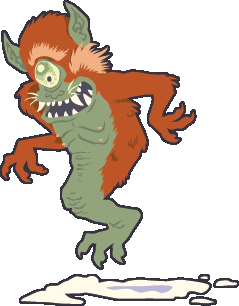
Ippon-datara
"This shy monster is rarely encountered by humans, and all that is usually seen of it is a single line of huge footprints about a foot across, winding through the snowy mountains of Wakayama prefecture.
"In Japanese, O is a prefix denoting respect, and bakemono literally means a changed thing - something perverted and altered and moved beyond its natural state - a monster.
"To most Western eyes, traditional Japan is a serene veneer of stoic samurai, porcelain-skinned geisha, Mount Fuji and cherry blossoms. It seems like the last place you'd look for things bizarre, grotesque, and morbid. And yet the Japanese archipelago is home to as rich a tradition of goblins, ghouls, and monsters as you'll find anywhere on Earth. Imported from the mainland along with Buddhism or Chinese culture, or springing from fertile local imaginations and ancient animistic traditions, this impressive array of animated objects, transformed animals, ogres, demons, and human freaks is known collectively known as yōkai (yoh-kye), or bakemono (bah-keh-mo-no). They feature in countless folktales, prints, and paintings, often rendered with as much humor as horror, a troupe of beasts as charming as they are terrifying.
"Sekien Toriyama was the first to catalogue Japan's vast bestiary, and in 1776 published a hefty illustrated tome called the "Hyakki Yakō", or "Hundred Demon Night Parade." Many since him have attempted to follow in his footsteps, the most notable among these being cartoonist Shigeru Mizuki, who has written and lavishly illustrated numerous books on the subject, all while keeping the yōkai alive in the public's imagination through his strange, enchanting comic stories.
"In English-speaking nations, Japan's popular culture has of late enjoyed immense popularity in the form of animation, comic books, and video games, and Godzilla and his fellow giant rubber-suit monsters have always had a cult following. But the kaijū's older cousins, the yōkai, remain largely a footnote and a curiosity in the West. Occasionally they sneak over in the form of a low-budget monster movie, or show up altered, toned-down, or romanticized into unrecognizability in an imported cartoon popular with teens. Yet much of the fertile, monstrous imagination contained in old Japanese folklore and art has never been collected, translated, and presented to the English-speaking world.
"With more than two hundred creatures slated to be illustrated and described, the Obakemono Project hopes to fill this void."
No comments:
Post a Comment